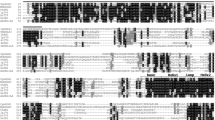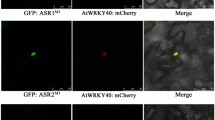Abstract
In the morning glory Ipomoea tricolor, the ivory-seed (IVS) protein, which bears a basic helix-loop-helix (bHLH) domain homologous to Arabidopsis transparent testa 8 (TT8) and petunia anthocyanin 1 (AN1) that activate various epidermal traits, was reported to regulate anthocyanin pigmentation in flowers and the dark-brown pigmentation in seeds. In this study, additional roles of the Ipomoea tricolor IVS (ItIVS) gene were elucidated and seed pigments of I. tricolor were also analyzed. Microscopic observations showed that trichomes on seed surface were reduced in seeds of the ivs mutant Blue Star (BS), closely resembling ivs mutant seeds of I. purpurea. Different from petunia AN1, the ItIVS gene appears not to be related to expression of the I. tricolor Na +/H + exchanger (ItNHX1) gene that increases petal pH during flower opening, because the expression profile of ItNHX1 in BS was virtually indistinguishable from that of the wild type Heavenly Blue (HB). The dark-brown pigments of HB were mainly composed of proanthocyanidins and phytomelanins. As phytomelanin content in BS seeds was about 22% of wild type level, and vanillin and ρ-dimethylaminocinnamaldehyde (DMACA) treatments for its immature seeds also showed weak positive reactions, it seems that the ItIVS gene partially activates the accumulation of both pigments. Some biosynthetic steps in anthocyanin and proanthocyanidin biosynthesis are thought to be common in Arabidopsis. However, the chalcone synthase D (CHS-D) and the dihydroflavonol 4-reductase B (DFR-B) genes in Ipomoea, which are essential for anthocyanin biosynthesis, were not transcribed in seed coats of HB, and a dfr-b mutant Pearly Gates (PG) still produces proanthocyanidins suggesting that ItIVS may activate different sets of structural genes for anthocyanin biosynthesis in flowers and proanthocyanidin production in seeds. Our results suggest that proanthocyanidin biosynthesis in morning glory is not accomplished by a unique system like it is in Arabidopsis, and more complicated processes are involved.
Similar content being viewed by others
Literature Cited
Choi, J.D., A. Hoshino, K.I. Park, I.S. Park, and S. Iida. 2007. Spontaneous mutations caused by a Helitron transposon, Hel-It1, in morning glory, Ipomoea tricolor. Plant J. 49:924–934.
Chopra, S., A. Hoshino, J. Boddu, and S. Iida. 2006. Flavonoid pigments as tools in molecular genetics, p. 147–173. In: E. Grotewold (ed.). The science of flavonoids. Springer, New York.
Dixon, R.A., D.Y. Xie, and S.B. Sharma. 2005. Proanthocyanidins — A final frontier in flavonoid research? New Phytol. 165:9–28.
Downie, A.B., D. Zhang, L.M.A. Dirk, R.R. Thacker, J.A. Pfeiffer, J.L. Drake, A.A. Levy, D.A. Butterfield, J.W. Buxton, and J.C. Snyder. 2003. Communication between the maternal testa and the embryo and/or endosperm affect testa attributes in tomato. Plant Physiol. 133:145–160.
Feinbaum, R.L. and F.M. Ausubel. 1988. Transcriptional regulation of the Arabidopsis thaliana chalcone synthase gene. Mol. Cell. Biol. 8:1985–1992.
Fukada-Tanaka, S., Y. Inagaki, T. Yamaguchi, N. Saito, and S. Iida. 2000. Colour-enhancing protein in blue petals. Nature 407:581.
Harki, E., T. Talou, and R. Dargent. 1997. Purification, characterisation and analysis of melanin extracted from Tuber melanosporum Vitt. Food Chem. 58:69–73.
Haughn, G. and A. Chaudhury. 2005. Genetic analysis of seed coat development in Arabidopsis. Trends Plant Sci. 10:472–477.
Hoshino, A., Y. Johzuka-Hisatomi, and S. Iida. 2001. Gene duplication and mobile genetic elements in the morning glories. Gene 265:1–10.
Hoshino, A., K.I. Park, and S. Iida. 2009. Identification of r mutations conferring white flowers in the Japanese morning glory (Ipomoea nil). J. Plant Res. 122:215–222.
Iida, S., Y. Morita, J.D. Choi, K.I. Park, and A. Hoshino. 2004. Genetics and epigenetics in flower pigmentation associated with transposable element in morning glories. Adv. Biophys. 39:141–159.
Inagaki, Y., Y. Johzuka-Hisatomi, T. Mori, S. Takahashi, Y. Hayakawa, S. Peyachoknagul, Y. Ozeki, and S. Iida. 1999. Genomic organization of the genes encoding dihydroflavonol 4-reductase for flower pigmentation in the Japanese and common morning glories. Gene 226:181–188.
Johzuka-Hisatomi, Y., A. Hoshino, T. Mori, Y. Habu, and S. Iida. 1999. Characterization of the chalcone synthase genes expressed in flowers of the common and Japanese morning glories. Genes Genet. Syst. 74:141–147.
Koes, R., W. Verweij, and F. Quattrocchio. 2005. Flavonoids: A colorful model for the regulation and evolution of biochemical pathways. Trends Plant Sci. 10:236–242.
Kondo, T., T. Kawai, H. Tamura, and T. Goto. 1987. Structure determination of Heavenly blue anthocyanin, a complex monomeric anthocyanin from the morning glory Ipomoea tricolor, by means of the negative NOE method. Tetrahedron Lett. 28:2273–2276.
Koornneef, M. 1990. Mutations affecting the testa color in Arabidopsis. Arabid. Inf. Serv. 27:1–4.
Morita, Y., M. Saitoh, A. Hoshino, E. Nitasaka, and S. Iida. 2006. Isolation of cDNAs for R2R3-MYB, bHLH and WDR transcriptional regulators and identification of c and ca mutations conferring white flowers in the Japanese morning glory. Plant Cell Physiol. 47:457–470.
Nicolaus, R. and M. Piattelli. 1965. Progress in the chemistry of natural black pigments. Rend. Acc. Sci. Fis. Mat. 32:83–97.
Park, K.I., J.D. Choi, A. Hoshino, Y. Morita, and S. Iida. 2004. An intragenic tandem duplication in a transcriptional regulatory gene for anthocyanin biosynthesis confers pale-colored flowers and seeds with fine spots in Ipomoea tricolor. Plant J. 38:840–849.
Park, K.I. and A. Hoshino. 2012. A WD40-repeat protein controls proanthocyanidin and phytomelanin pigmentation in the seed coats of the Japanese morning glory. J. Plant Physiol. 169:523–528.
Park, K.I., N. Ishikawa, Y. Morita, J.D. Choi, A. Hoshino, and S. Iida. 2007. A bHLH regulatory gene in the common morning glory, Ipomoea purpurea, controls anthocyanin biosynthesis in flowers, proanthocyanidin and phytomelanin pigmentation in seeds, and seed trichome formation. Plant J. 49:641–654.
Ramsay, N.A. and B.J. Glover. 2005. MYB-bHLH-WD40 protein complex and the evolution of cellular diversity. Trends Plant Sci. 10:63–70.
Shirley, B.W., S. Hanley, and H.M. Goodman. 1992. Effects of ionizing radiation on a plant genome: Analysis of two Arabidopsis transparent testa mutations. Plant Cell 4:333–347.
Spelt, C., F. Quattrocchio, J. Mol, and R. Koes. 2002. ANTHOCYANIN1 of petunia controls pigment synthesis, vacuolar pH, and seed coat development by genetically distinct mechanisms. Plant Cell 14: 2121–2135.
Author information
Authors and Affiliations
Corresponding author
Rights and permissions
About this article
Cite this article
Park, K.I. A bHLH protein partially controls proanthocyanidin and phytomelanin pigmentation in the seed coats of morning glory Ipomoea tricolor . Hortic. Environ. Biotechnol. 53, 304–309 (2012). https://doi.org/10.1007/s13580-012-0006-6
Received:
Revised:
Accepted:
Published:
Issue Date:
DOI: https://doi.org/10.1007/s13580-012-0006-6




